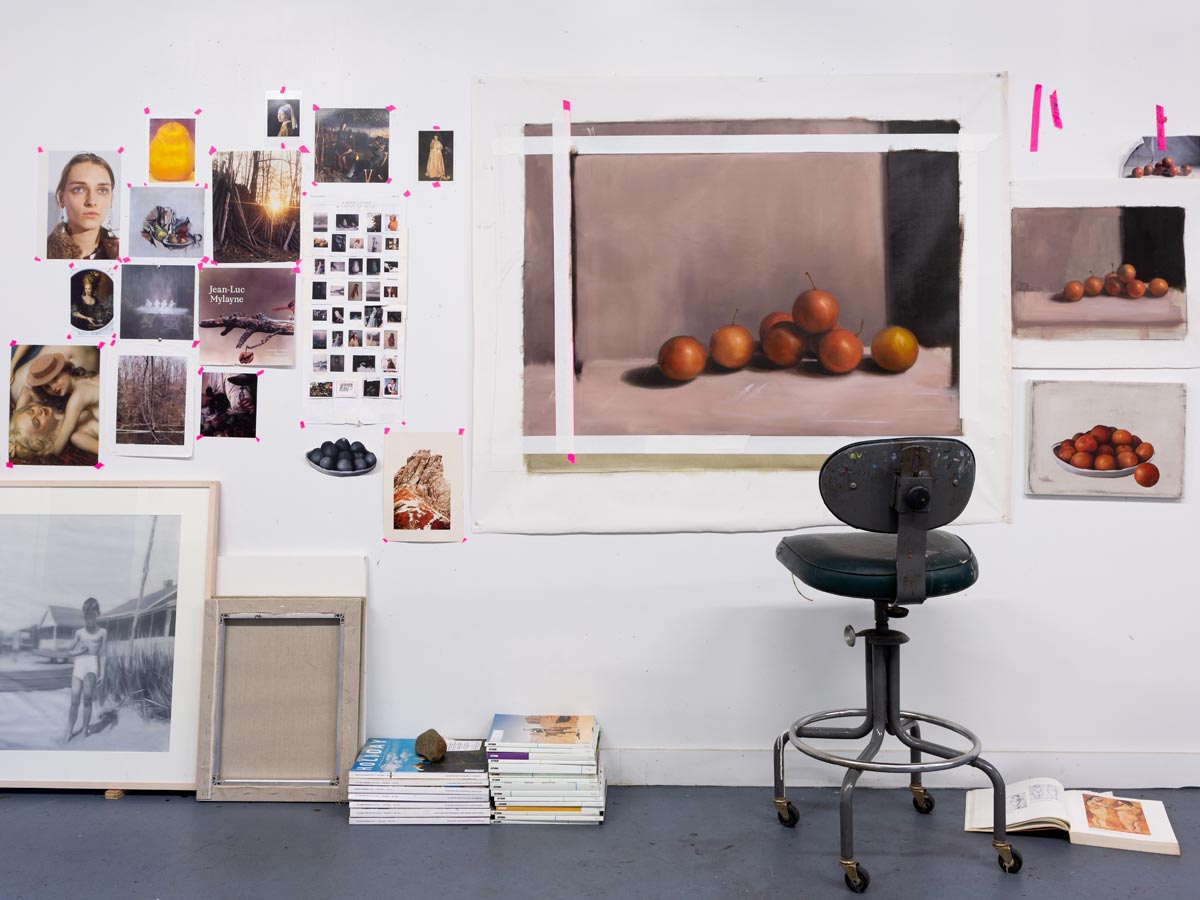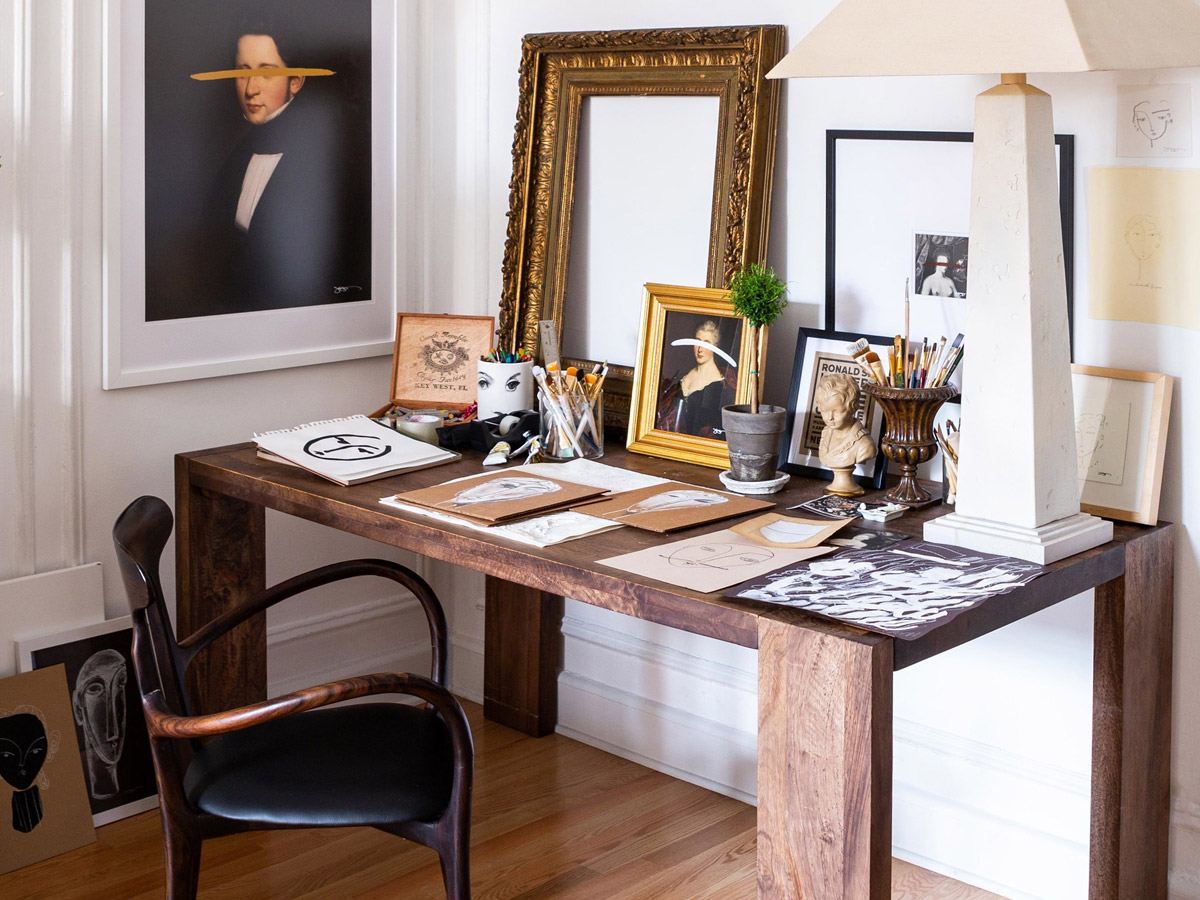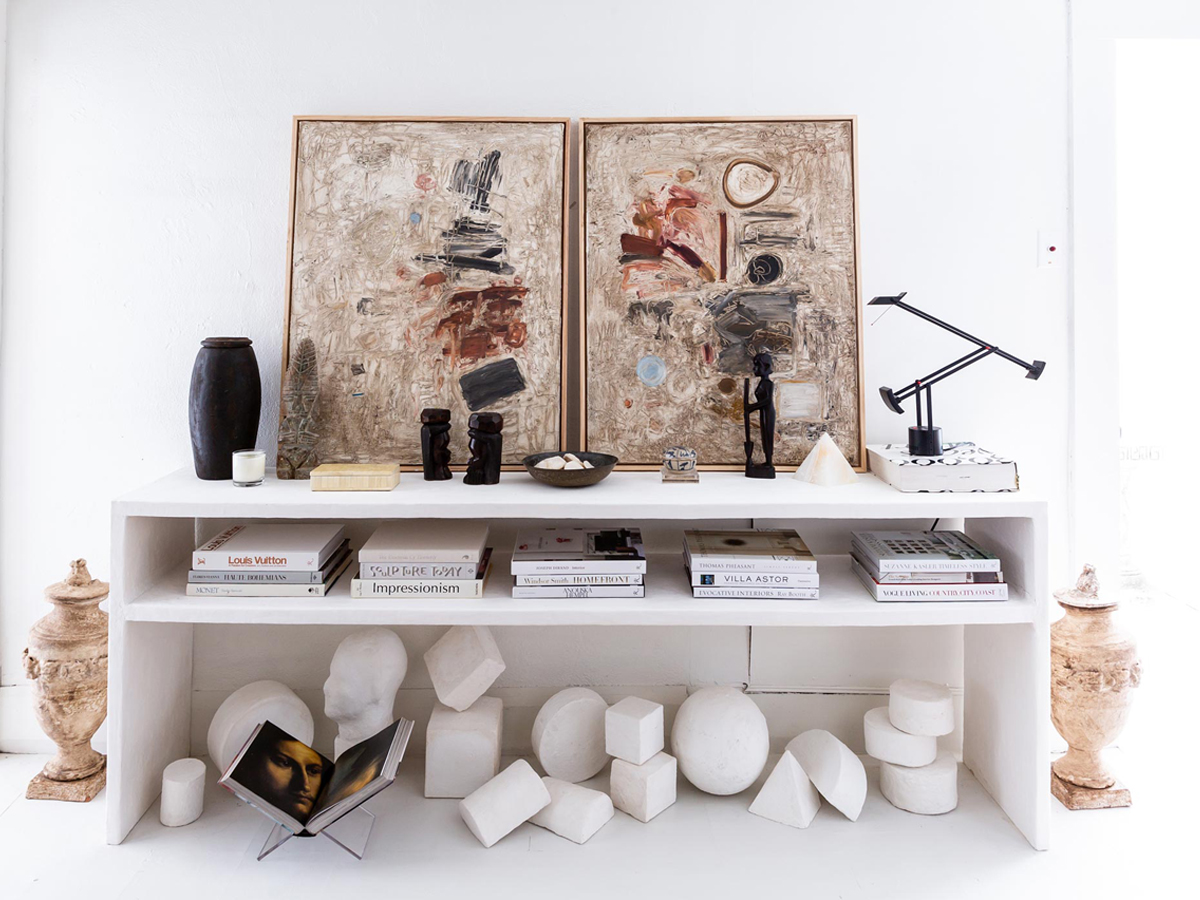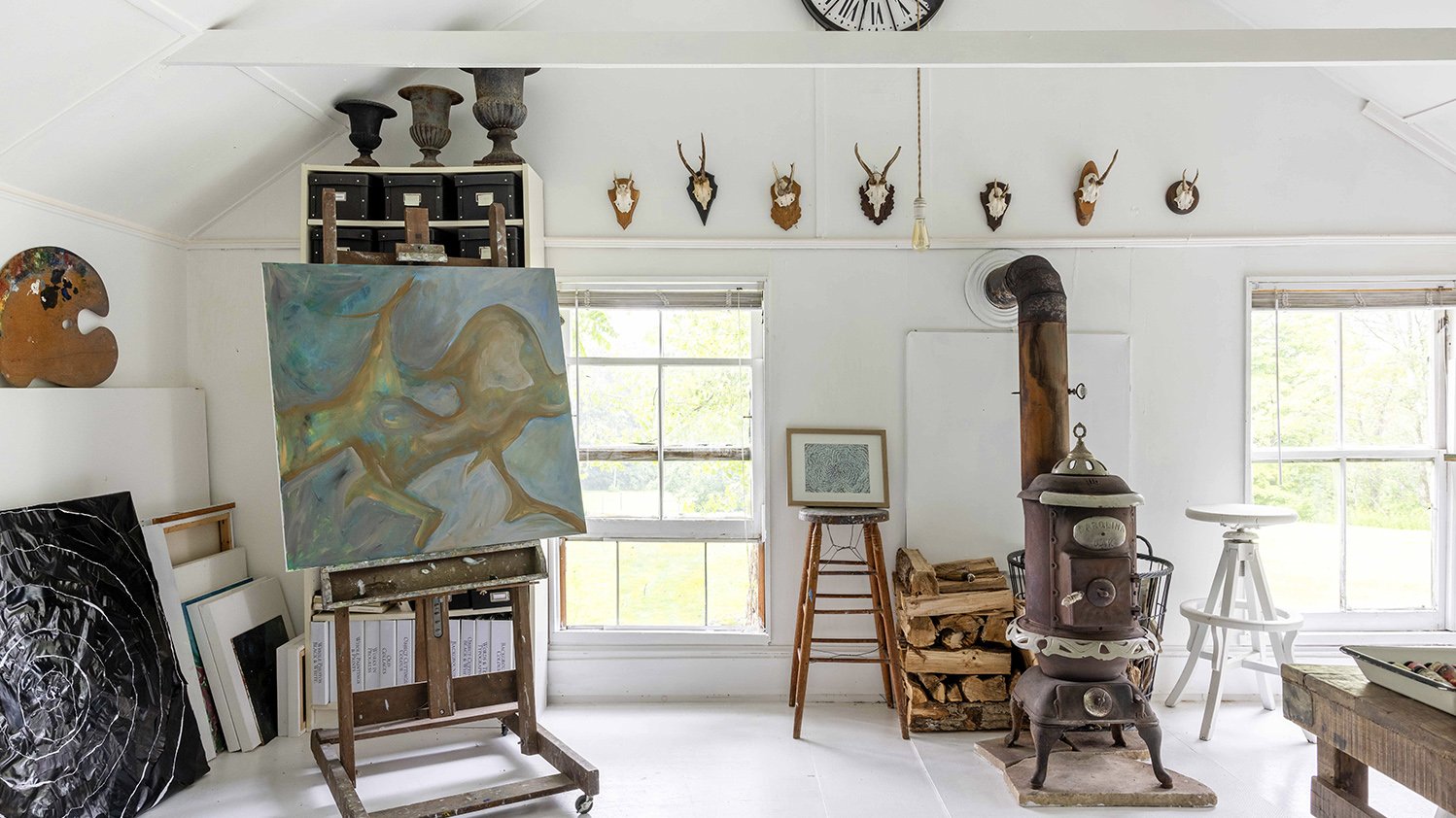Karyn Lyons and Her Harlem Studio

Written by S. Pajot | Photographed by Marta Xochilt Perez | Produced and Art Directed by Michelle Adams | Portrait Photographed by Georgia Nerheim
A true artist cannot be bothered with such trivial concerns as hunger. Just ask painter Karyn Lyons. “I remember my old studio mate remarking, ‘You don’t even sit down for lunch.’ And I don’t. I just keep working,” she says. “Maybe I’ll eat paint-covered pretzels,” she adds with a laugh. “Not very healthy.”
Lyons spends nearly every day, even most weekends, in her Harlem studio. Rarely eating. Always working. “I’m a little obsessive about painting,” she admits. “I get up. I go to the gym. I go right to my studio. And I’m there all day till 6:30, 7. Then I come home.” And the next day is usually just like the last. “I paint every day that I can be painting,” she says.
Unlike her previous work space at the now-defunct Oracle Club, a bustling art salon in Long Island City, Lyons’s Harlem studio rarely gets visitors. “Now I’m completely alone, which has its advantages and its disadvantages,” she says. “One of the disadvantages is the lack of sense of community.” Thankfully, Lyons has fallen in with painter Colleen Herman and once-a-week art gathering Sunday Salons. “That’s brought a whole new group of women artists into my life.”
Sometimes, though, life interferes. “I will do work on the side,” Lyons explains, referring to the freelance styling and art direction jobs that she picks up with clients such as J.Crew, Victoria’s Secret, Levi’s, Old Navy, and OshKosh. “Or it’s family. Or the doctor. Or the dentist.” And the occasional press interview, too. “In fact, because I’m talking to you and I’m not in my studio—because I would be in my studio right now,” Lyons points out, with a playfully accusatory emphasis on those last nine words, “I said, ‘OK, Wednesday is a day off.’ So I’m going to go to the Guggenheim today to see the Klimt show.” Her obsession is all-consuming. “If I’m not painting, I’m thinking about painting or I’m looking at paintings.”
“I felt, until I started to paint full-time, that it was missing from my life. It just changed everything.”
Oddly, as overwhelmed as she is with this lust for her craft, Lyons didn’t begin seriously considering a career in art until her early 30s, after she’d already begun another field of work. “My third-grade teacher told me, ‘One day, you are going to be a famous artist.’ And I never forgot it,” she says. “But I didn’t really do much art until I was an adult. I would take a class, here or there, in high school. I took some classes in college.
“I had been discouraged by family and friends; they told me not to pursue it,” Lyons explains. “With my family, it was for financial reasons, because making art is a very difficult way of making a living. Then when I showed my very first attempts at painting to my then-boyfriend, he said to me, ‘Stick to cooking,’ which is hilarious. But none of it stopped me because I loved it.”
“When I’m going to paint, I look at paintings,” Lyons says. “And I’m omnivorous when looking for inspiration in other painters. I like everything from early Renaissance, such as Piero della Francesca, to the 20th-century still lifes of Giorgio Morandi. Just thinking about Morandi’s paintings gives me an emotional rush.”
A graduate of American University, in Washington, DC, Lyons had studied journalism and communications. (“And I’m not a very good writer,” she remarks, kiddingly.) Straight out of school, she worked in advertising and PR, which led to a five-year stint at Polo Ralph Lauren, which then led to another five years at J.Crew. “Now, I’m actually very grateful that I was discouraged from pursuing a full-time art career because I learned so much from working,” Lyons says. “The commitment to excellence, hard work, discipline: I learned those things working at those places.”
I love thinking about how I can make an apple glow, with light and color and chiaroscuro, while putting my feelings onto it.
Still, she knew that her calling was elsewhere—in front of a canvas, in a studio of her own. So she went back to school, enrolling in the graduate studies program at the School of the Museum of Fine Arts at Tufts University, in Boston. “I had amazing mentors, like Ann Craven and María Magdalena Campos-Pons, who really showed me a way to look at art that I had never been exposed to before,” she says. “I had been used to just taking a life-drawing class or that kind of thing. And there was only one life-drawing class at the Museum School. Most of it was theory. There wasn’t a lot of actual painting being done. The art was happening in your head.”
The furniture in Lyons’s studio is purely functional. An old, paint-flecked desk chair to lean on while working. A work table for tubes of paint and coffee cans full of brushes. “The only time that I will go sit at a table is if I’m struggling. I’ll flip through a book to see how somebody else handled this,” she says. “Or sometimes, I’ll use those tables to set up a still life, and I’ll photograph it.”
These days, in her studio on the ground floor of the Westbourne, a residential building built in 1906 in the Hamilton Heights section of Harlem, Lyons can’t stop painting—though the art is still happening in her head, too. “I work in series, and they are narrative series,” she explains. “So I will think about what I want to paint about, and usually, it’s the same types of themes, whether it’s beauty, the passage of time, desire, mortality.” Ripe fruit dangling from bent branches at twilight; a woman’s slightly parted, lipstick-smudged, perhaps-just-kissed lips; a boy on a black-and-white beach, painted as if from a memory of a lost photograph.
When a painting is going well, Lyons keeps it out to be seen. When a painting is going badly, she turns it toward the wall. “If people start riffling through things that aren’t being shown, I’m like, ‘They’re not being shown because I don’t want them to be. Those are things that I’m not happy about,’” she says. “It’s almost like someone reading your journal. As an artist, in the process of making work, you want certain things to be private.”
There are unstretched works in progress tacked to the walls, finished canvases hung in mini exhibition, and half-completed pieces that she’s turned against the wall, away from curious eyes. “Some paintings go very quickly and easily, but most do not,” Lyons says. “Sometimes, I’m painting from observation, but most often, I’m composing as I’m painting, which isn’t the most efficient way of working, but that’s the way I do it. I don’t usually make preparatory sketches; I just start.”
And once she’s started, she does not pause. Not for phone calls. Certainly not for meals. It’s a painstaking way to work. But she just can’t tear herself away from the painting. It must be done. Until it is finished. “And it can take a very long time,” Lyons says. “There are moments when a painting is doing really well, and there are other moments when a painting is doing really badly. I will start a piece, and it will change many, many times. Days and days and days might pass. But the trick is to just keep going. And never eat,” she laughs. “It’s important to stay hungry.”







